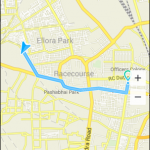Gear Check: The Four Things You Need for Navigation on a Long Cycling Trip
I could barely keep my eyes open as I wandered down the long corridor through the airport in Lisbon. Would my bike be waiting for me at the baggage claim? I had been traveling for 35 hours, and before that, had been up late the night before having a minor panic attack thinking about the enormity of what I was undertaking. How was I going to find my way across Europe, cycling out of the Lisbon airport? I wouldn’t have a cell network, or wifi on the road, it was just me on my bicycle for the next 5 months, cycling across Europe.
I had researched bike routes and roads across Europe before I left, and was planning on cycling south from Lisbon, then following the coast all the way to Italy. I knew I would learn things on the road, from other cyclists and travelers, about the best roads to take and even the best place to enter a country. A map might show a road across a border, but that checkpoint might now be closed, or unsafe. All these things are unknown before you get close enough to make those particular decisions. It’s just not possible to plan an entire route for that long of a trip.
I wandered into the baggage claim, scanning the crowds of people and conveyor belts. All of a sudden, I spotted it. A sign that read ‘oversized luggage’. In a small, dark corner, there it was— a giant cardboard box with my bike in it. I balanced the enormous box on a cart, sped through security, and was deposited into a bustling, cavernous room that was the main terminal. I scouted around for a quiet corner to assemble my bike. For the next hour I sat there, quietly piecing together my bicycle as people wandered by giving me odd looks. Once it was together, I left the cardboard box leaning up against the wall (per security’s instructions) took my bike up an escalator to the south side of the airport (another horrifying moment, clutching a bicycle loaded down with 30 pounds up an escalator) but did it nonchalantly anyway, waiting for it to slip out of my grasp at any moment. I wheeled my bike toward two sliding glass doors, and all of a sudden, I was out in the European sunshine. I hopped on my bike, and started pedaling south. It was the most surreal thing I’ve ever done.
* * *
For your next trip, to avoid minor panic attacks regarding navigation, I’ve put together this list of the four things you need on a long-term cycling trip. There are other things you need too, like common sense, an open mind, and good communication with other cyclists and locals— but from a strictly gear standpoint, don’t head out into the sunshine without these.
 1. Bike Computer
1. Bike Computer
I use this CatEye Urban Wireless Bike Computer. It’s really easy to install, it works with a small sensor attached to your front spoke with the computer mounted on your handlebars. It only costs $45, and best of all, the display doesn’t overheat when biking all day in hot weather, like other bike computers I’ve seen. It does all the basics, like mph/kph and distance traveled, has big type for easy reading on the road, and is the best piece of equipment I had on my cycling trip.
 2. Paper Maps
2. Paper Maps
I used National Geographic Adventure maps almost the entire cycling trip. Not only did they come in handy when wifi wasn’t available, but they also listed campsites and local attractions along the route. They’re laminated with a matte finish and virtually impossible to destroy.
 3. Compass
3. Compass
For most of Portugal, I just made sure I was heading south and didn’t bother to get on wifi or check my paper maps aside from scouting out the next camping spot. When all else fails, it’s great to have a compass to check the road direction.
 4. Smart Phone with Offline Maps
4. Smart Phone with Offline Maps
I realized this gem several countries into my trip, and it would have made my life up until then far easier. Surprise! There are offline maps. I started using Maps.me, which is free, and even with no network shows you where you are on the map, and does routing. Many a time I came upon a confusing roundabout in France, and handy Maps.me was there to guide me. *Don’t flash your smart phone around. Bring a cheap Nokia to use with local sim cards and leave your smart phone locked up.
5. GPS*
GPS devices are expensive, and I think, not necessary. I came across a lot of cyclist who had them though, so if you already own one by all means bring it. You can’t go wrong with directional backup, particularly if you’re on a long trip.
